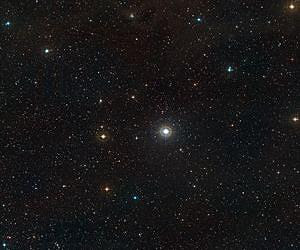This wide-field image of the sky around the unusual double star SS Leporis is a colour composite made from exposures from the Digitized Sky Survey 2 (DSS2).
The field of view is approximately 2.7 degrees. SS Leporis is the bright star at the centre.
Astronomers have obtained the best images ever of a star that has lost most of its material to a vampire companion.
By combining the light captured by four telescopes at ESO's Paranal Observatory they created a virtual telescope 130 meters across with vision 50 times sharper than the NASA/ESA Hubble Space Telescope.
Surprisingly, the new results show that the transfer of mass from one star to the other in this double system is gentler than expected.
"We can now combine light from four VLT telescopes and create super-sharp images much more quickly than before," says Nicolas Blind (IPAG, Grenoble, France), the lead author on the paper presenting the results.
"The images are so sharp that we can not only watch the stars orbiting around each other, but also measure the size of the larger of the two stars."
The astronomers observed the unusual system SS Leporis in the constellation of Lepus (The Hare), which contains two stars that circle around each other in 260 days.
The stars are separated by only a little more than the distance between the Sun and the Earth, while the largest and coolest of the two stars extends to one quarter of this distance - corresponding roughly to the orbit of Mercury.
The hot companion has already cannibalized about half of the mass of the larger star, because of this closeness.
"We knew that this double star was unusual, and that material was flowing from one star to the other," says co-author Henri Boffin (what a great name for a scientist), from ESO.
"What we found, however, is that the way in which the mass transfer most likely took place is completely different from previous models of the process. The 'bite' of the vampire star is very gentle but highly effective."
The new observations are sharp enough to show that the giant star is smaller than previously thought, making it much more difficult to explain how the red giant lost matter to its companion.
The astronomers now think that, rather than streaming from one star to the other, the matter must be expelled from the giant star as a stellar wind and captured by the hotter companion.
"These observations have demonstrated the new snapshot imaging capability of the Very Large Telescope Interferometer. They pave the way for many further fascinating studies of interacting double stars," concludes co-author Jean-Philippe Berger.







No comments:
Post a Comment